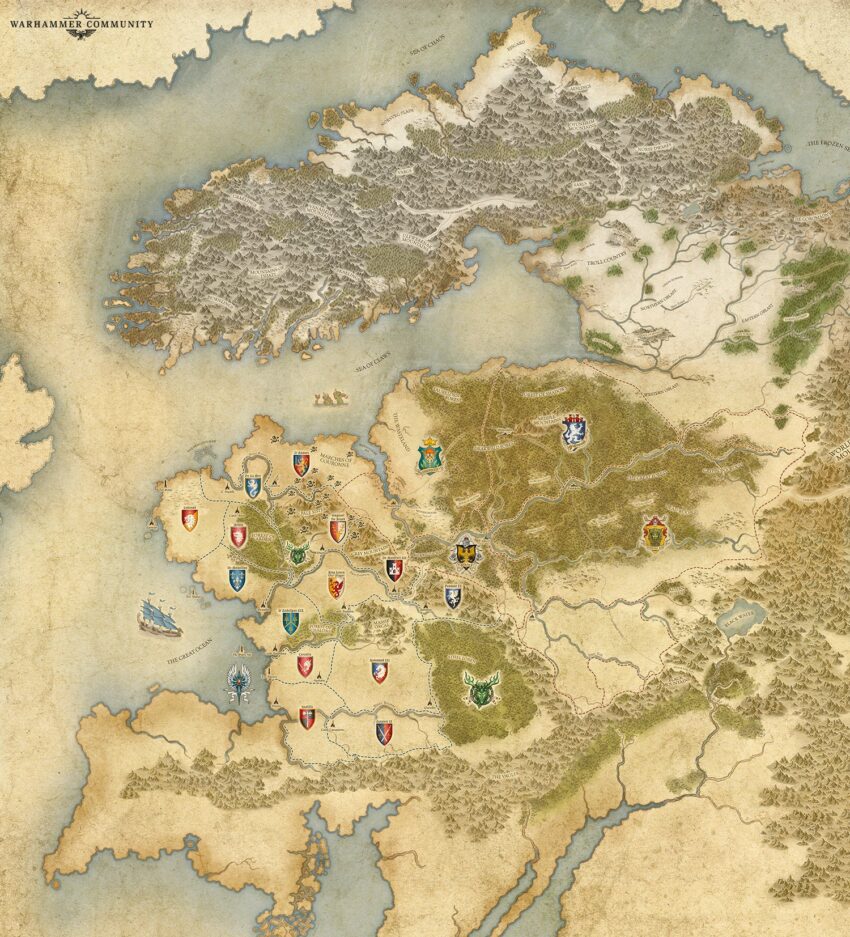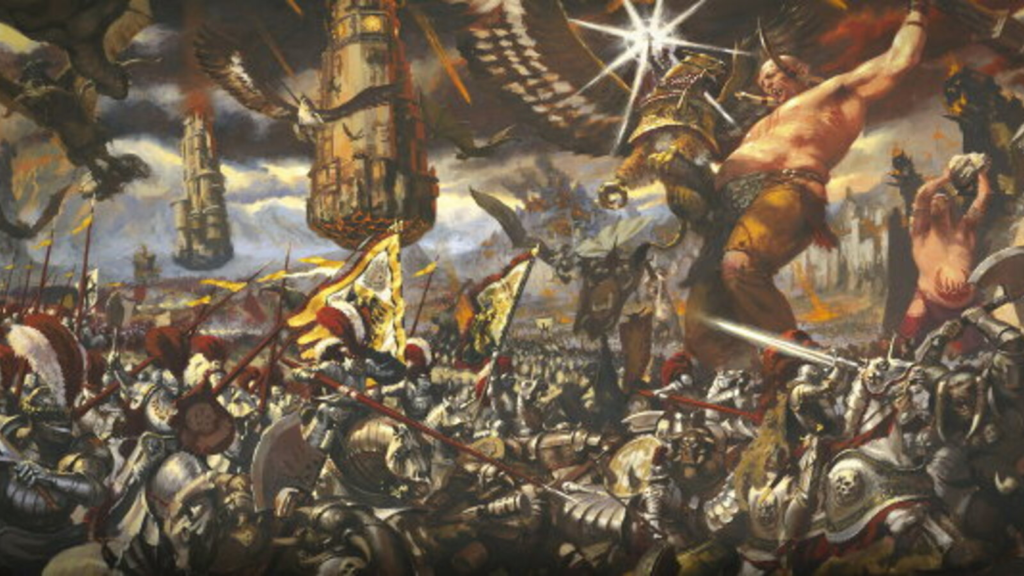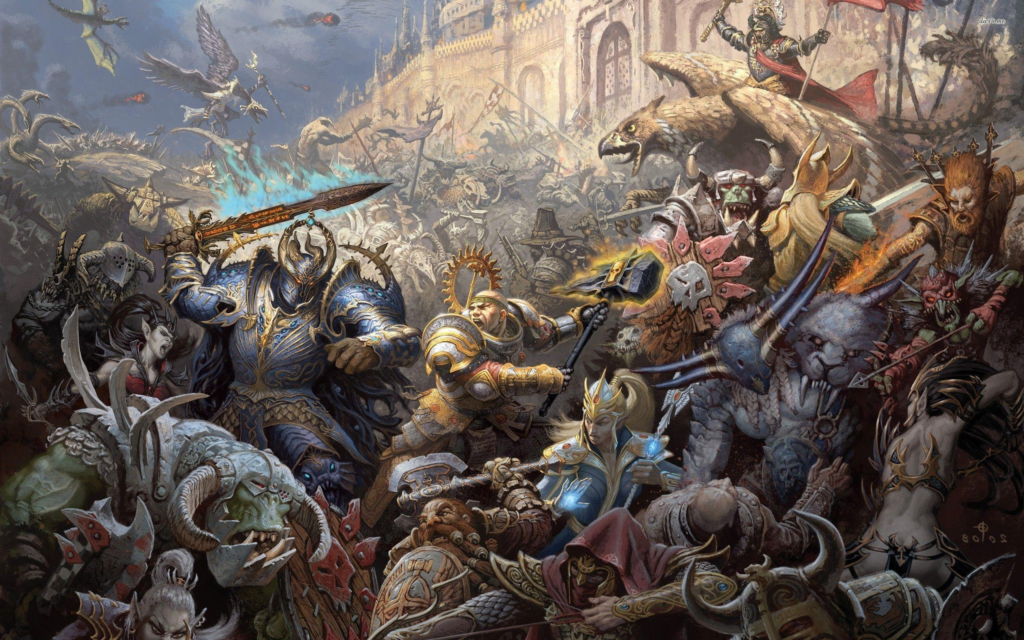Hi All,
I recently ran a warhammer fantasy narrative mission for my local club. Since the mission rules are quite long I will split it into two articles. In today’s article we will go over the narrative and how I tried to set it up to accommodate a number of players. While this game was played using the 8th ed WHFB rules it could also be tweaked to work with WAP as well.
Narrative:
Teppichstadt and Tapisville had long coexisted on the opposite sides of a tributary of the river Brienne. By a quirk of geography, both towns developed a small, closely guarded, tradition of carpet weaving with each boasting theirs were the finest in the land. Each town was also ruled by an aggressive guild that monopolized regional competition and established de-facto rule over their sides of the tributary (to the chagrin of their lieges).
Needless to say, this would inevitably lead to conflict. Over the course of the past several months the region saw an influx of rare materials including the famed Bretonnian Swap Lilac, the Chracen spiral snail as well as many other coveted dye making objects. The seller of these luxury goods has sought to pit both sides against each other, inflaming long building animosity.
Foreseeing an eventual conflict, both towns have been pooling their considerable resources for months to hire mercenary bands for “protection”. The guilds have long been famed for their accumulation of wealth, as opposed to good sense, and thus have ended up with a very motley band of troops. Elves of all kinds rub soldiers with empire mercenaries, dwarfs and abominations of various stripes lured with promises of relics or payment and largely held in check by their mutual greed.
Last night, the local Bretonnian lord gathered the feuding elders and the merchant at the local tavern (The Loquacious Boar) to resolve the conflict. Progress was slow, but growing until one of the Tapisville burghers made an uncharitable remark about the thread count of Teppichstadt carpets. The offended party quickly retorted that such expensive materials would be wasted on by sophomoric talents of the Tapisville weavers to say nothing of their reductive, derivative, designs. Within minutes the assembly was reduced to a brawl that just as suddenly emptied out as each side remembered they had hired mercenaries to do the fighting for them.
As the cold light of dawn illuminates the ground between the two cities, shambolic armies begin moving into position…
Rules:
Now there were never firm rules on conducting a apocalypse-style battle for warhammer fantasy. In order to try and accommodate larger armies I adopted the following rules:
Turns: Teams will share turns and move through each phase as a unit.
Magic: When determining the winds of magic each player on the casting side will roll 1 D6 and add that result to another “global” dice rolled for the whole table, or 2 dice if the game is played above 2,000 points. (E.g. players 1,2, and 3 roll a “1”,”5” and “3” respectively. The global roll for the table is a “4” thus Player 1 has 5 power dice, Player 2 has 9 power dice and Player 3 has 7 power dice).
o Dispell dice are also rolled individually except the rolling player may choose to swap their roll for the global roll if that result is higher.
o Players on the same side are not allowed to share the dice from their pool with other players after the dice have been distributed
o Only one player per side may attempt to dispel any given spell, but they are allowed to try to dispel a spell cast against any unit on their side, including units commanded by other players.
Reserves: Units arriving using the Ambushers special rule do not roll but instead come in automatically at the start of turn 2. If the player’s army is not on the wings of the battlefield then the ambushing units may arrive from any selected piece of terrain. Units with the Ambushers rule may also be set up as if they did not have this rule.
Allied Armies: Players may not have their characters join any units other than their own. However, units drawn from the same army book on the same side may benefit from abilities of allied friendly units (general’s leadership, BSB, etc.) but these abilities will never stack.
Deployment: To start, each team will roll-off and alternate placing their generals on the board. Each side will then submit a bid with the minimum amount of time needed to deploy. Whoever submits the lowest bid will deploy their army first (and get +2 on their roll to go first). Players will then deploy units using the bid they submitted (even if it isn’t the winning bid). Once the side with the winning bid is finished deploying the opposing team will deploy. Any units not placed in time will enter as reserves.
o Players are free to deploy their units anywhere on the battlefield within 36” of their general. Unless the unit selected has the “Ambusher” or “Scout” special rule
The Mission:
The mission itself was split into two different domains. The players are mercenaries and thus they care almost as much about their own prestige as they do about completing the objective. This conflict is represented by how players can win in different ways. At the end of the narrative players could win in one of two ways:
- Their objective the towns hired the players to do would be to fight over objectives. These could be controlled using a rubric with the unit with the highest score within 6″ controlling the objective.
- If the Unit is core: +1
- If the Unit has a Hero/Lord in it: +1
- If the Army’s BSB is in the unit: +1
- If the army’s general is in the unit: +1
- Players could acquire glory through issuing challenges and completing bonus objectives. This is to represent the competition between the mercenary groups fighting to show who is the best.
- Glory points could be acquired in several ways:
- Player has a Hero/Lord unit compete in a challenge against a Hero/Lord unit: +1
- Player has a Hero/Lord unit compete in a challenge against a Hero/Lord unit, in which your unit has a lower points value then the opponent: +1
- Player has a Hero/Lord unit compete in a challenge against a Hero/Lord unit, in which your unit is unmounted and your opponent is mounted: +1 (+3 if opponent has a monstrous mount)
- Player has a Hero/Lord unit win a challenge against a Hero/Lord unit: +2
- Player’s General or BSB is within 6” of an objective: +1
- Player has the most units controlling objectives on their team at the end of their turn (ties are ignored): +1
- Player’s General dispels a spell with irresistible force: +1
- Players will be given an “Objective Card” at the start of each turn. If they achieve this objective by the end of the game, they will earn the listed bonus Glory Points. Document with these objectives is attached.
While this seems quite complicated large battles move pretty quickly in this setting allowing more room for custom rules. Speaking of custom rules I also made event cards that are drawn randomly at the start of each round. These are customized to the objective and can be positive or negative for the controlling player. These event cards are also attached (please forgive any spelling errors).
Final Tweaks:
the last adjustments I made based on my own uncertainty of how many people would come. If we had a large number of players not only would the models be difficult to fit, it would also take forever. Thus I implemented the following rule:
- Army size is 3000 points per player unless we get 8+ players in which case the army size will be 2000 per player
This does require people to bring multiple lists but hedges on time nicely. I also had two new objectives (marked as the Wizard’s Hut and the Graveyard on the events sheet) in case we needed another table to fit more people.
*Phew* well that covers the set up, check back in later in the week to see the pictures and hear about how the mission worked!
Files:
And remember, Frontline Gaming sells gaming products at a discount, every day in their webcart!







